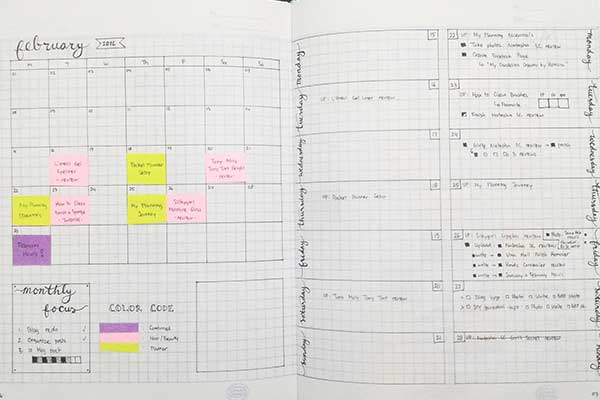
Creating Effective To-do Lists
Let’s kick this New Year into high gear with less junk and more effective methods of getting things done! Here are a few theories and principals behind the ultimate to-do lists! Booyah!
Borderline Genius Bullet Journaling Ideas
An analog system for the digital age is what we could call bullet journaling. Wide open for expression and more.
All you need is a notebook and a pen.
Break your days into time periods: morning, afternoon, and evening. Complete your tasks in periods not “oh damn I did nothing today periods!”
Bullets should be used as short, objective sentences that contain three categories: Tasks, Events, and Notes.
Tasks are represented by a dot. And include any actionable items.
- X = Task Complete
- > = Task Migrated
- < = Task Scheduled
Events are represented by an “O” Bullet.
Notes are represented with a dash “—“.
Signify your bullets by Priority, Inspiration and Exploration.
To learn more about bullet journaling from an analog perspective, take a peek at BulletJournal. It’s beautiful.
Spend a little money on your journal and pens. You will be more thoughtful with your pen to page and more honest with yourself on what really has to get accomplished and isn’t just noise.
For some additional creative and colorful ideas to bullet journals check this out! Pinterest is a world full of journals that makes us feel a little lazy just looking through them all!
Get Your Ass Academic
There is a time management expert out there named James Clear who chats about a method called the Ivy Lee Method—the daily routine experts recommend for peak productivity.
Let’s call it the $400,000 technique. But why? Ivy Lee, the man who founded this method, taught it to Charles Schwab and his executives in 1918— and told them to pay whatever it was worth. Three months later, Lee had a check for $25,000. That’s the equivalent of $400,000 now!
This is dead simple. Here’s what you do:
- Write down the six most important things you need to accomplish tomorrow.
- Rank those items in order of importance.
- Work on your first item until it’s finished. Then, move onto the next.
- When the day is done, transfer unfinished items to a new list of tasks for tomorrow.
James Clear has a theory about why this method works: it’s simple, forces you to prioritize tasks, and makes it easy for you to single task. Boom. To-do list conquered.
Go Old School, Baby!
Colored notecards are old school. Give each notecard one task. This isn’t the most environmentally friendly plan, but counteract by planting a few trees or something! There is a blog out there called The Small Stuff Counts and she rocks the note card to-do list “method”. Shuffle them by priority and avoid the stuff you don’t love doing. Not our favorite method, but it just might work for you!
The Kanban Method
Kanban is great for teams and those who like to see the big picture at a glance. When using the method, you’ll have all of your tasks, due dates, and task progress in front of you, so there’s nothing keeping you from diving right into your work.
Andrew Kunesh writes about 8 Powerful Ways to Manage Your Tasks on Zapier. Worth a quick looksie!
The Pareto Principle
The Pareto Principle, also known as the 80-20 rule, states that around eighty percent of results come from only twenty percent of the effort. Or, to put it another way, most of the progress towards your goals comes from a few accomplishments.
Based on that principle, the Harvard Business Review recommends that you only focus on one of your six priorities for the day. Then, do that task alone for ninety minutes. If you find yourself drawn to a particularly cute cat video, write down the task again — essentially slapping yourself on the wrist with a reminder to get it done.
Looking for a new notebook to help you get organized? Try MOO’s new Hardcover Notebook. With lay-flat binding and 160 pages of Munken Kristall paper, it’s smart and beautiful.
We love MOO products here at Bound-by Marketing! MOO into the New Year successfully.
